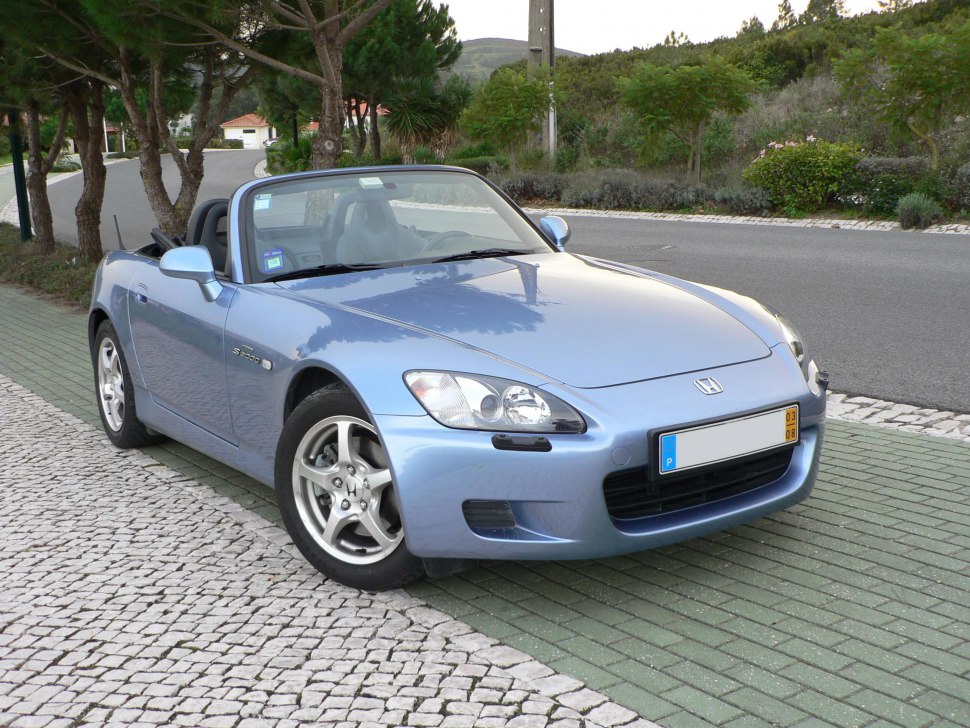
MarioM [Public domain], from Wikimedia Commons
S2000 is one of Honda’s most prominent vehicles. It’s an open top sports vehicle, produced between 1999 and 2009. The very first glimpse of the Japanese racer was during the 1995 Tokyo Motor Show, where the manufacturer displayed a concept of the S2000. Four years later, in 1999, the production version was introduced.
According to the manufacturer’s official announcements, the name S2000 comes from the 2.0 l engine’s displacement.
Honda S2000 was produced between 1999 and 2009. During that time, the manufacturer launched two variations – AP1 and AP2.
AP1 was released in 1999 with 2000 stated as a model year. The cars in this line came equipped with a 2.0 l (F20C I4) front-mid-engine, generating power of 237–247 hp (241–250 PS) and torque of 208–218 Nm (153–161 lbf⋅ft) depending on the car market. The aggregate, mounted behind the front axle of the car, was mated with a 6-speed manual transmission.
The implemented type of suspensions was a double wishbone. Steering type was electrically assisted, while the wheels were 16-in. The dimensions that the car sported were as follows: 2,400 mm (94.5 in) wheelbase, 4,120 mm (162.2 in) length, 1,750 mm (68.9 in) width and 1,285 mm (50.6 in) for height. The kerb weight was 1,274 kg (2,809 lb).
Part of the standard trim was the vinyl top with internal cloth lining. It was electrically powered. A little later, in 2001, Honda offered the S2000 with an optional aluminum hardtop.
Notable elements of the interior were the digital clock, leather gearshift knob, and console cover.

Stefan-Xp [CC BY-SA (http://creativecommons.org/licenses/by-sa/3.0/)], from Wikimedia Commons
Since it was a success in the USA, the model was offered with a special color palette for the American market – Berlina Black, New Formula Red, Grand Prix White, Sebring Silver, and Silverstone Metallic.
AP2, known in Europe as AP1 facelift, came in 2004 and was in production until 2009. The cars from the line were equipped with new 17-in wheels. The suspension unit was revised (compared with the AP1) in order to handle the oversteering better. Among the technical changes that Honda applied were revised shock absorber damping, spring rates, suspension geometry. The vehicle’s sub-frame was reinforced. Brand new material, carbon fiber, was introduced and used for the gearbox.
The exterior of the S2000 was also refreshed. Brand new bumpers, fresh headlights, LED rear lights as well as re-designed exhaust pipes. Most of the before mentioned changes did not apply for the Japanese, Australian and European model lines. The engine line for those market remained the 2.0 l one.
However, for North America, the Japanese car maker introduced new aggregate – more powerful and significantly lightweight 2.2 l one with 2,157 cc (131.6 cu in) displacement and torque of 220 Nm (162 lbf.ft) at 6,800 rpm. The fuel consumption of the cars was significantly cut off.
The 2.2 l engine was introduced to the Japanese market in 2006 – with an increased power of 239 hp (242 PS) and 221 Nm (163 lbf.ft). Along with that, the model offered an ESP control, new wheels, Laguna Blue Pearl exterior color and seats, and additional stereo speakers.
Honda launched a special edition for the US market, Club Racer, in 2008. It debuted during the 2007 NYAS and sported reduced vehicle mass, new exhaust system, wheels painted in a darker color, stiffer suspension, new tires, black lug nuts.

Sayantsi at the English Wikipedia [GFDL (http://www.gnu.org/copyleft/fdl.html)], from Wikimedia Commons
As for the exterior, the body kit showcased revised front lip, bigger spoiler and hard top as an optional trim. The interior color scheme was restricted to yellow and black Alcantara only.
In the period between 2008 and 2008, Honda launched Type S – solely for the Japanese market. The car shared a lot with the America Club Racer’s editions, like the reduced weight, sportier body kit, along with the wheels and interior (yellow and black Alcantara). Honda’s engineering team revised the suspension set up so that the car would offer better and easier handling. It came with a soft top and was sold only in Japan.
For the UK, Honda released a GT trim. It had a hard-top (removable) and externally mounted gauge for measuring temperatures.
In 2009, just before closing the line, Honda released two limited editions – Ultimate Edition and GT Edition 100. The first one was intended for continental Europe, while the second one – for the UK. Models displayed visible changes – like new body color (Grand Prix White), removable hard top, new color alloys (graphite), red leather upholstery, red stitching on the gear lever.
In 2009, the model was discontinued due to poor sales numbers.